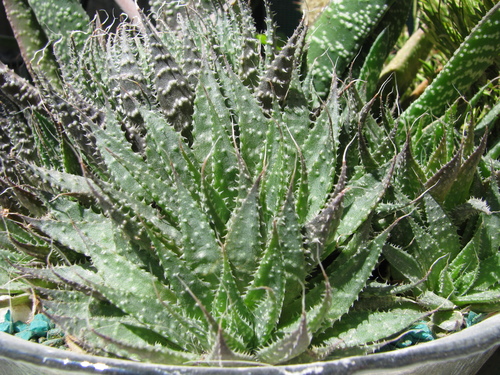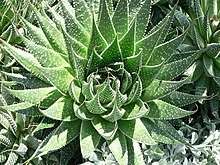Lace Aloe
Search
Wikipedia
| Aristaloe aristata | |
|---|---|

| |
|
Scientific classification | |
| Kingdom: | Plantae |
| Clade: | Tracheophytes |
| Clade: | Angiosperms |
| Clade: | Monocots |
| Order: | Asparagales |
| Family: | Asphodelaceae |
| Subfamily: | Asphodeloideae |
| Tribe: | Aloeae |
| Genus: |
Aristaloe Boatwr. & J.C.Manning[2] |
| Species: |
A. aristata
|
| Binomial name | |
|
Aristaloe aristata | |
| Synonyms[1] | |
| |
Aristaloe is a genus of evergreen flowering perennial plants in the family Asphodelaceae from Southern Africa. Its sole species is Aristaloe aristata,[3] known as guinea-fowl aloe or lace aloe.
Naming and taxonomy
This species is known locally as "serelei" (Sesotho for "slippery one") or "langnaaldaalwyn" (Afrikaans for "lacey aloe"). In English it is usually known as the "lace aloe" or "guinea-fowl aloe".
The species was described by Adrian Hardy Haworth. Its species name "aristata" comes from the Latin for "bristly" or "awned", and refers to the lacy edges of the leaves. Its generic name has the same etymology. Recent phylogenetic studies have demonstrated that the genus Aloe is polyphyletic and that this unusual species is not in fact an aloe, but is more closely related to Astroloba and to the four "Robustipedunculares" species of Haworthia. It has therefore been moved to its own genus, Aristaloe, to account for its separate ancestry and genetic uniqueness.[4]
Description
It is stemless, sawtoothed and succulent. The soft succulent leaves grow in rosettes, and are lanceolate with bristly margins.
Its nectar-rich, tubular orange flowers tend to attract birds, bees, and wasps easily. When not in bloom, it is similar to and often confused with some other species, such as Haworthiopsis fasciata.[5]
Distribution
It is indigenous to South Africa and Lesotho. Its natural range extends from the Karoo region of the Northern Cape and Eastern Cape Provinces of South Africa, eastwards through the Free State and Lesotho, as far as the borders of Kwazulu-Natal Province.
Within such a wide range, this adaptable little species inhabits a range of environments, from the dry, sandy Nama Karoo, to the high grasslands and cold mountain slopes of Lesotho, and the shady forested valleys of KwaZulu-Natal.[6]
Cultivation
It is commonly cultivated as a garden plant around the world. It prefers well-drained soils, but can tolerate a range of rainfall systems. It can also tolerate temperatures down to -7 °C, due to its adaptation to cold mountain tops. However it may need to be grown indoors or under glass in extremely cold temperate regions, to give it some winter heat. This clumping species readily produces large numbers of off-sets, which can be separated and planted as a means of propagation.
It has gained the Royal Horticultural Society's Award of Garden Merit.[7]
References
- ^ a b "Aristaloe aristata". World Checklist of Selected Plant Families. Royal Botanic Gardens, Kew. Retrieved 2017-10-16.
- ^ "Aristaloe". World Checklist of Selected Plant Families. Royal Botanic Gardens, Kew. Retrieved 2017-10-16.
- ^ "Search for Aristaloe". World Checklist of Selected Plant Families. Royal Botanic Gardens, Kew. Retrieved 2017-10-16.
- ^ Manning, J.C., Boatwright, J.S., Daru, B.H., Maurin, O. and Van der Bank, M. 2014. A molecular phylogeny and generic classification of Asphodelaceae subfamily Alooideae: A final resolution of the prickly issue of polyphyly in the Alooids? Systematic Botany 39(1):55-74.
- ^ "Aloe aristata, Serelei (Slippery One Aloe), Torch Plant, Lace Aloe, Information and Cultivation Tips". succulents.co.za. Retrieved 15 September 2017.
- ^ "Threatened Species Programme | SANBI Red List of South African Plants". redlist.sanbi.org. Retrieved 15 September 2017.
- ^ "RHS Plant Selector - Aloe aristata". Royal Horticultural Society. Retrieved 14 March 2020.
External links
| Wikimedia Commons has media related to Aristaloe aristata. |


